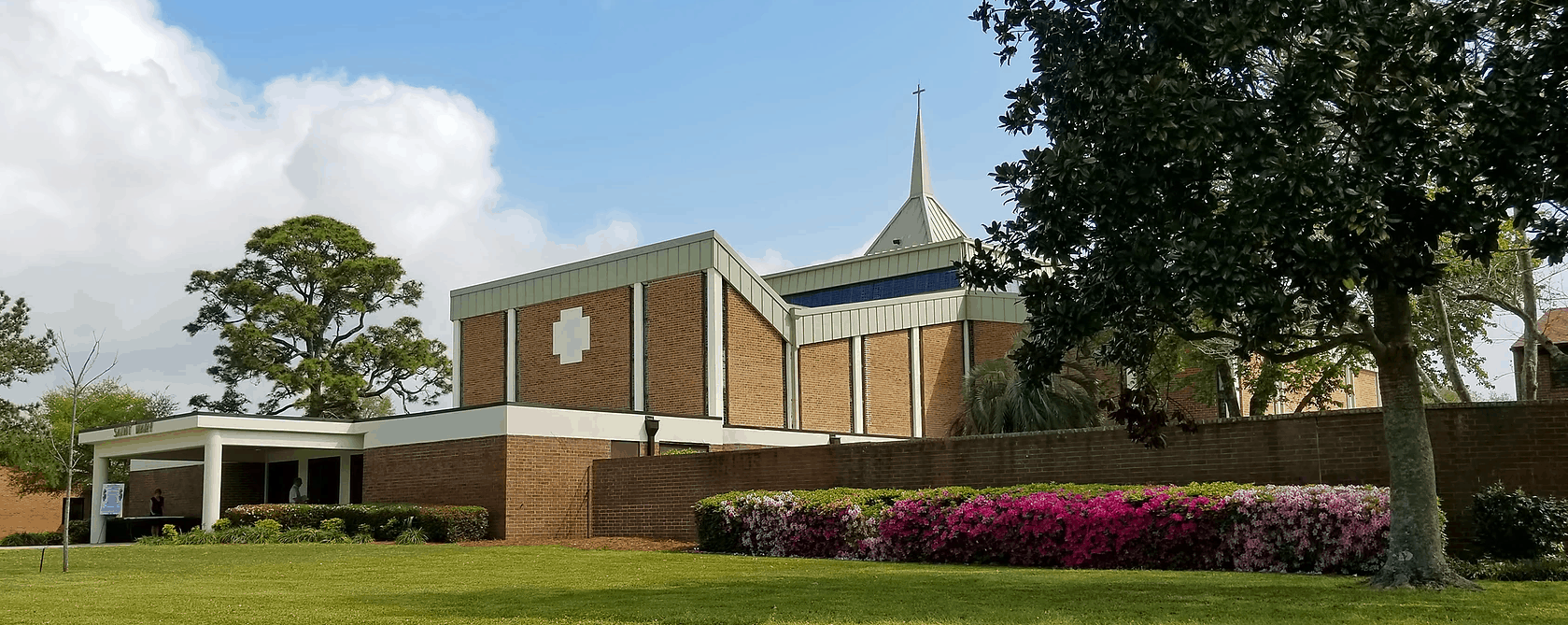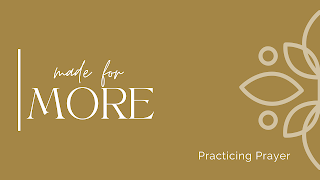Made for More Week 2: Practicing Prayer
Made for More Week 2: P.R.A.Y.
This is the second week of our message series Made for more.
In the Gospel reading today, as Jesus is leaving Jericho with his followers, Bartimaeus, whom we know very little about, calls out: ‘Son of David, have mercy on me!’ and persists even though the crowd tries to silence him. Jesus has them bring the man to him and asks what he wants; he asks to be able to see again. Jesus tells him that his faith has cured him; he immediately regains his sight and follows Jesus.
Apart from reporting this miracle that shows the power of Jesus, the author of the Gospel uses this story to advance a clearly theological purpose. It shows a character who understands who Jesus is and the proper way to respond to him – with faith. And how do we express our faith now? How do we call out to Jesus for help with our own blindness in our lives whether spiritually or physically? It happens in prayer.
And we have a knack for overcomplicating prayer when prayer doesn’t have to be complicated. We have a tendency to think prayer has to be spoken eloquently, when in fact God just wants us to speak from the heart. Lots of times when we speak from the heart it doesn’t sound or look good especially when we recognize our need.
We have a tendency to think that prayer is a part of our relationship with God when in fact it IS our relationship with God. Personal and communal prayer is the way we have a relationship with God.
A major part of prayer is conversation and communication between God and us. As God cures our spiritual blindness, prayer helps us to see as God sees.
In any sort of training, whether it’s physical or mental, we are told the way you practice is the way you will perform or play. It’s the same with prayer. In the past the church has used a Latin saying, “Lex oriendi, lex credendi,” which means “you believe as you pray.” In other words, how you pray is how you will practice your faith; it defines what you believe and who you are.
So if you find prayer to be overly complicated and you aren’t sure how or where to even start, I want to give you a simple way to pray by using the letters of the word pray: P – R – A – Y. Each letter will help you to remember what prayer is by following it.
Praise takes our thoughts and directs them vertically – towards God –worshipping Him for who He is and for what He has done. The “P” of praise reminds us that prayer is primarily a vertical, God-focused act.
When you begin your prayer with Praise, you are approaching God with total respect and honor. Prayer is first and foremost about God’s glory. Praise reminds us of who God is and who we are in His sight.
Jesus’ own model of prayer, given to His disciples when they asked, “Lord, teach us to pray,” is recorded in Matthew 6. He teaches us to begin vertically, “Our Father in heaven, hallowed be Your name. Your kingdom come, Your will be done.” It’s good to begin our prayers by focusing first on God and His agenda.
Start your prayer by telling God something you appreciate about His character and why: “Father, I praise You for Your love, Your justice, Your holiness, Your kindness, Your faithfulness, Your grace, Your presence, etc.” Praise God for who He is and what He has done, offering Him your thanks.
The R is for repent. When we put our faith in Christ, it’s true that we are totally forgiven of all our past, present, and future sins. Because of that full and free forgiveness, our relationship with God has been established. Yet, we still sin. And those ongoing sins disturb our fellowship with our heavenly Father, and sometimes even break it.
This is why we need to repent of our sins and confess them to God, and sometimes to a priest in reconciliation. In first John we read, “If we confess our sins, He is faithful and just to forgive us our sins and to cleanse us from all unrighteousness”. To confess is “to say the same thing” God says about our sin. It’s no longer making excuses but agreeing with God that your attitudes and actions are sinful.
Jesus constantly calls us to a lifestyle of repentance. To repent is to change your mind about a belief or a behavior that produces a change of life. It’s making a U-turn with our lives. It’s turning from an old way of thinking and living that enables us to live new.
As you pray, take some time to allow the Holy Spirit to reveal your sins. It might be helpful to think through various areas of your life: sins of thought, sins of attitude, sins of relationships, sins of omission, sins of commission, sins of self-rule, or sins of self-reliance. Call your sin a sin! Don’t make excuses for them. And ask God for the grace to repent. Ask God to restore your fellowship. And then thank God that your sins are forgiven. You can rest in His unfailing love.
When our hearts are God-oriented in praise and purified through repentance, then we are ready to “Ask.” No doubt there are many things you would like to see God do for your family members, for your friends, and for yourself.
God encourages us to come boldly to Him and ask. Scripture tells us, “Let us then with confidence draw near to the throne of grace, that we may receive mercy and find grace to help in time of need”. And also, “You do not have, because you do not ask”. We ask for what we need and trust God in his providential love to give us what we need.
The Y stands for yield. We must be willing to yield our desires and our thoughts to God’s sovereign wisdom. Our model is Jesus. As He faced the cross, He prayed, “My Father, if it be possible, let this cup pass from Me; nevertheless, not as I will, but as You will.” We must pray with that same spirit, humbly yielding our will to God’s will.
In prayer, we recognize that God is in control. When we submit to God’s will, we understand that the outcome is His to decide and ultimately what He decides is what is best for us.
As God’s children, we don’t always know what’s best for us. The Father knows best. Instead of grumbling about “unanswered” prayers, we can thank God that He doesn’t always answer our prayers the way we think He should. When we pray for God’s will to be done, we shouldn’t be trying to manipulate God into rubber-stamping what we have already decided needs to happen in our lives.
We close our prayer by “yielding” to God which is a way that we submit our desires to Him. In the end, it is our way of acknowledging that His will is what will truly satisfy us anyway. God’s will and plan is better than ours. His foresight is further and his love is greater than we have for others and even ourselves.
Through prayer we come to realize that we are made for more. God loves us and wants a relationship with us. Period. Once we believe that, it can change everything.
So I want to encourage you this week, to use the P.R.A.Y. acrostic. Take five minutes sometime during your day and begin to try it. Our daily devotional will be taking a letter per day, so it can be a great way to get started as well. If you don’t pray regularly, Jesus is inviting you into a relationship with him. Why not start today?


